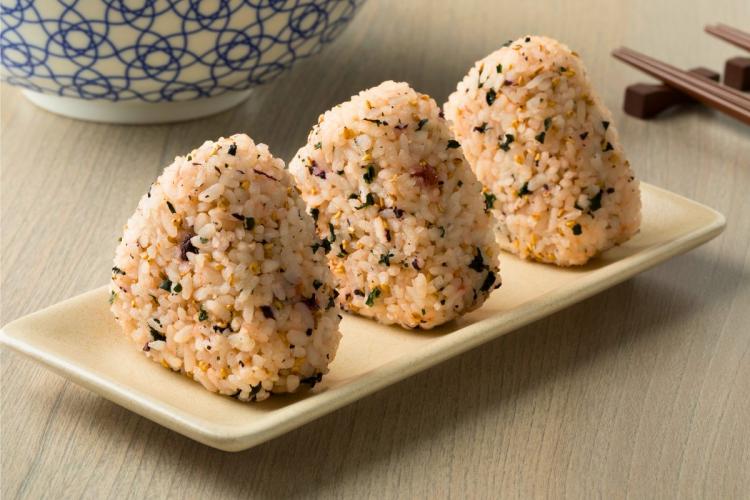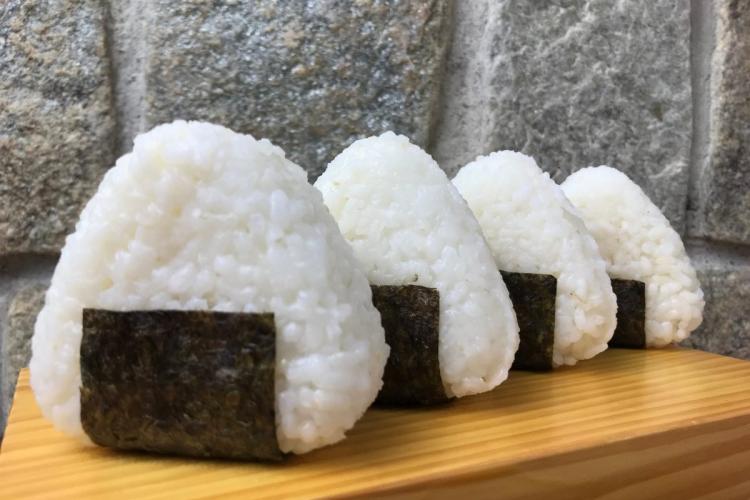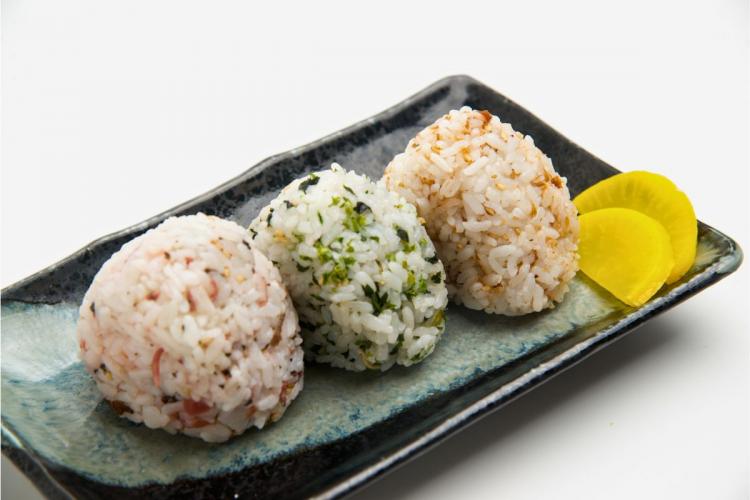How to wrap onigiri
Step-by-step instructions for making delicious Japanese rice balls.
Ready to dive into the delicious world of onigiri, the versatile Japanese rice ball snack? Whether you’re a seasoned chef or just trying out Japanese cuisine, making onigiri is a fun and satisfying endeavor. This blog post will guide you through the steps of creating your very own onigiri, from choosing the right rice to learning how to wrap onigiri with crispy nori seaweed sheets. You’ll also discover the fascinating history and cultural significance of onigiri, as well as creative filling ideas and storage tips. Let’s get rolling!
Japanese rice balls for everyone
- Learn the basics of making onigiri, a delicious and culturally significant Japanese snack
- Choose the right rice and nori seaweed sheets to make perfect onigiri with savory or sweet fillings
- Store & enjoy your homemade onigiri in an airtight container for maximum flavor & texture!
The art of onigiri and understanding the basics
Onigiri, also known as Japanese rice balls, are a classic snack that has been a staple in Japanese culture for centuries. These delicious treats, often referred to as onigiri Japanese, can be filled with a wide variety of ingredients, from traditional picks like pickled plums to inventive fillings like last night’s dinner leftovers. The beauty of onigiri lies in its simplicity, requiring just a few ingredients such as freshly cooked rice, nori seaweed sheets, and the filling of your choice.
Embarking on your onigiri-making journey opens up a world of endless possibilities for shapes, types, and flavors.
History and cultural significance
Onigiri has a rich history dating back over two thousand years to the Yayoi Period in Japan (300 BCE to 250 CE). Back then, it served as a convenient, portable snack for travelers and soldiers, often filled with salty or sour ingredients to act as a natural preservative. The use of salt as a preservative was especially important, as it allowed onigiri to be carried around without spoiling.
Today, onigiri continues to be a popular quick snack in Japanese culture and can be found in convenience stores and homemade lunchboxes alike. The traditional savory fillings, such as cooked tuna, cooked salmon, and pickled plums, can still be found in onigiri today. However, modern twists on this classic snack have led to a wide variety of fillings and combinations, making onigiri a delicious and customizable treat for any palate.
Shapes and types of onigiri
Onigiri can take a variety of forms, including triangles, balls, and cylinders, showcasing the versatility of this delightful snack. For beginners, a triangular shape is recommended as it’s the traditional and most recognizable form. As you become more confident in your onigiri-making skills, you can experiment with other shapes like flattened rounds or tawara (cylinders).
Utilizing an onigiri mold ensures the creation of consistently shaped and beautiful rice balls, eliminating the hassle of hand-shaping. These handy tools allow you to portion the rice and press it into the desired shape, resulting in perfectly formed onigiri every time. Whether you choose to shape by hand or use a mold, practice is key to mastering the art of onigiri.
Essential ingredients for perfect onigiri
The creation of the perfect onigiri requires two essential ingredients: the appropriate type of rice and nori seaweed sheets. Choosing the right rice is crucial, as short-grain Japanese rice has the ideal texture and stickiness for onigiri. Nori seaweed sheets not only add flavor to your onigiri but also make it easier to hold and enjoy. With these ingredients in hand, you’re ready to start crafting your own delicious onigiri creations.
Choosing the right rice
The backbone of any onigiri is the rice, and using Japanese short-grain rice ensures the perfect texture for your rice balls. Koshihikari sushi rice is an excellent choice for onigiri, as it has the desired stickiness and flavor.
Using warm rice when shaping your onigiri enhances its ability to hold its form. By choosing the right rice, your onigiri will not only taste delicious but also maintain their form as you enjoy them.
Nori seaweed sheets
Originating from species of the red algae genus Pyropia, nori seaweed sheets are fundamental to onigiri for their role in wrapping the rice balls and enhancing flavor. Roasted nori seaweed sheet is the best choice for onigiri, offering a crisp and savory taste that complements the rice and fillings.
To keep your nori sheets fresh and crispy, store them in an airtight container in a cool, dry place. With the right nori seaweed sheets, your onigiri will be both delicious and easy to hold.
Preparing your onigiri: Cooking and seasoning the rice
Properly cooking and seasoning the rice is a critical step before you start shaping and filling your onigiri. Here are the steps to follow:
- Rinse the rice thoroughly to remove excess starch.
- Soak the rice in water for about 30 minutes.
- Cook the rice according to the package instructions or using a rice cooker.
- While the rice is still hot, season it with a pinch of salt, sugar, rice vinegar, or furikake, a Japanese rice seasoning.
Taking the time to prepare your rice correctly guarantees a delicious and satisfying onigiri experience.
Cooking the rice
The first step in cooking onigiri rice is:
- Rinsing it in a bowl of cold water until the water runs clear, removing excess starch and ensuring a better texture.
- After rinsing, soak the rice for 30 minutes to help the grains absorb water and cook more evenly.
- Once soaked, the rice can be cooked using a rice cooker or on the stovetop, following the appropriate water-to-rice ratio for Japanese short-grain rice (1 to 1.1 or 1.2).
To cook the rice using a rice cooker, simply add the rinsed and soaked rice with the correct amount of water and follow the manufacturer’s instructions. If using a stovetop, boil the rice and water in a pot with a tight-fitting lid, then reduce the heat and let it simmer for about 20 minutes until all the liquid is gone and the rice is tender. Once cooked, let the rice cool a bit before molding it into the desired onigiri shapes.
Seasoning the rice
Seasoning the rice is an essential step in creating flavorful onigiri. The most common method is to use a combination of salt, sugar, and rice vinegar to add taste and balance to the rice. Alternatively, furikake, a Japanese rice seasoning, can be used to add an extra layer of flavor to your onigiri.
Seasoning your rice with soy sauce enhances the overall taste of your onigiri, transforming it from a simple rice ball to a scrumptious and satisfying snack.
How to shape and fill onigiri
With your rice now cooked and seasoned, you can proceed to shape and fill your onigiri. This can be done by hand or with the help of an onigiri mold for a more consistent appearance. No matter which method you choose, practice is key to mastering the art of onigiri and creating beautiful, delicious rice balls with your chosen fillings.
Shaping by hand
Shaping onigiri by hand requires a bit of technique and patience. To prevent the rice from sticking to your hands, wet them with water and then salt them to add flavor to the rice.
Next, grab a portion of cooked rice, preferably plain steamed rice, and gently squeeze it into a mound, shaping it into a triangle or round shape with your hands. Be sure to press the rice firmly enough for it to hold its shape, but not so firmly that it becomes dense or clumps together.
Using an onigiri mold
For those who prefer a more consistent and hassle-free approach to shaping onigiri, using an onigiri mold is a great option. Here’s how to use it:
- Sprinkle some salt over the mold to enhance the flavor of the rice and prevent sticking.
- Fill the mold halfway with warm rice.
- Add your desired fillings.
- Cover the fillings with more rice.
- If your mold comes with a tamper, gently press down on the rice to shape it.
To remove the onigiri from the mold, simply flip it over and press the button on the bottom, releasing the perfectly shaped rice ball. Whether shaping by hand or using a mold, remember that practice makes perfect, and soon you’ll be crafting beautiful and tasty onigiri with ease.
How to wrap onigiri with nori seaweed sheets
Once your onigiri is shaped and filled, it’s time to wrap it with nori seaweed sheets, adding flavor and making it easier to hold.
There are two main methods for wrapping onigiri: the traditional technique, which involves folding the nori sheet around the rice ball and folding the ends to finish the shape, and the convenience store-style wrapping, which uses individually packaged nori sheets to keep the nori crispy until ready to eat.
Traditional nori wrapping technique
The traditional nori wrapping technique requires cutting or tearing the nori sheet into thin strips or thirds and folding it around the cylindrical or triangular rice ball shape. Some people prefer to wrap the rice balls when they’re warm so the nori sticks to the rice, but most people opt for keeping the nori as crisp as possible by allowing the rice to cool before wrapping.
By mastering the traditional nori wrapping technique, you’ll create authentic and flavorful onigiri that showcase the best of Japanese cuisine.
Convenience store style wrapping
For those who prefer to keep their crispy nori until the moment they’re ready to eat their onigiri, convenience store-style wrapping is an excellent choice. Individually packaged nori sheets can be found at Japanese or Korean markets and are designed to maintain their crispiness until consumption.
To wrap your onigiri, simply follow these steps:
- Place the onigiri in the center of the nori sheet.
- Fold the sides of the nori sheet over the rice.
- Secure the wrap with parchment paper, a band, or a string.
With this convenience store-style wrapping, your onigiri will stay fresh and crispy until you’re ready to enjoy this delicious snack.
Creative onigiri fillings and variations
While traditional fillings like tuna mayo and salted salmon are delicious, don’t be afraid to get creative with your onigiri fillings and variations. From savory to sweet and everything in between, the possibilities are endless when it comes to crafting your perfect onigiri. By experimenting with different types of rice, seasonings, and fillings, you can create a truly unique and personalized rice ball experience.
Savory fillings
Savory fillings for onigiri can range from traditional Japanese ingredients like spicy tuna, kombu tsukudani (simmered kelp), and plum rice, to more unconventional options such as charred corn or even last night’s leftovers from dinner.
Don’t be afraid to get creative and think outside the box with your onigiri fillings, as this versatile snack can accommodate a wide range of flavors and textures, making it a delicious and customizable treat for any palate.
Sweet fillings
For a dessert-like twist on the classic onigiri, consider exploring sweet fillings. Options like sweetened red bean paste, sweetened chestnut paste, or even fruit and chocolate can provide a delightful contrast to the savory rice and nori seaweed. Experimenting with sweet fillings can add an entirely new dimension to your onigiri experience, transforming this traditional snack into a delectable treat that everyone will love.
Storing and enjoying onigiri
Storing properly and understanding the best ways to enjoy your onigiri is vital for maximizing the enjoyment of this versatile snack. Whether you prefer to savor your onigiri hot, cold, or at room temperature, following the right storage techniques and enjoying your onigiri in the way that suits you best will ensure a delicious and satisfying experience every time.
Storage tips
To keep your onigiri fresh and tasty, follow these steps:
- Store them in the refrigerator or freezer.
- Consume them within a few days for optimal freshness and taste.
- When storing your onigiri, wrap them in plastic wrap or store them in a small airtight container.
- Keep the nori seaweed sheets separate until you’re ready to eat.
Following these storage tips maintains the delicious flavor and texture of your onigiri, positioning them as a convenient and appetizing snack or meal option.
Enjoying onigiri
Onigiri can be enjoyed in a variety of ways, making it a versatile and satisfying snack or meal option for any occasion. Whether you prefer your onigiri hot, cold, or at room temperature, this delightful rice ball can be easily adapted to suit your preferences. For an authentic and enjoyable onigiri experience, eat it with your hands, as it’s not meant to be eaten with utensils.
Embracing the versatility of onigiri and experimenting with an array of flavors, shapes, and fillings unveils a world of delicious possibilities that will entice you for more.
Onigiri rice balls
In this blog post, we’ve explored the fascinating world of onigiri, from its rich history and cultural significance to the art of shaping, filling, and wrapping this versatile Japanese rice ball snack. With a variety of shapes, types, and fillings to choose from, onigiri is a customizable and delicious treat that can be enjoyed in countless ways. By following the steps and tips provided in this guide, you’ll be well on your way to mastering the art of onigiri and creating your own delicious rice ball creations. So why not give it a try and discover the endless possibilities of onigiri for yourself? Don´t forget the soy sauce.
Frequently asked questions about onigiri rice balls
How do you wrap onigiri fully?
Wrap your onigiri with a nori seaweed sheet by folding it in half and then tearing or cutting along the fold. Add the rice, and then fold the two edges of the seaweed onto the rice. Finally, fold the whole triangle of rice away from you and onto the seaweed to complete the wrap.
How to pack onigiri for school lunch?
Wrapping your Japanese rice balls in plastic wrap will keep the moisture in and keep the surface from drying out. You can also add a pack of seaweed or chocolate chip rookie for an extra special touch. Enjoy!
How do you shape onigiri without mold?
Wet your hands and shape a triangle of warm sushi rice in your hand, then add a filling in the center before patching up the hole with more rice. Finally, pack the rice tightly to create a triangular onigiri shape.
How do you wrap onigiri with your hands?
Using your hands, flatten the rice and add a tablespoon of filling in the middle, then form it into a triangular shape by cupping your fingers in a "c" shape while patting the rice together. This will give you the perfect onigiri wrap.
What can I put inside onigiri?
Onigiri is a popular Japanese snack and can be filled with a variety of different ingredients such as tuna mayo, salted salmon, pickled plum, tarako, bonito flakes, kombu seaweed, canned tuna and spicy salted cod roe. Furikake is also commonly used to sprinkle over the top for additional flavor.
Is onigiri a type of sushi?
Onigiri and sushi are two separate dishes in Japanese cuisine. While they may look similar, they have different functions and preparation methods.
Onigiri is a rice ball made from plain rice that is often wrapped in nori, a type of dried seaweed. It is a portable snack that can be eaten anywhere. Onigiri usually has a filling in it as well, such as pickled plum, tuna with mayo, salmon and cream cheese, dried bonito flakes, chicken and vegetables.
Sushi, on the other hand, is made from vinegared rice and other ingredients such as seafood, vegetables, and sometimes tropical fruits. Sushi is often served in bite-sized pieces and eaten with chopsticks. Sushi is made to preserve fish.
Onigiri is not a type of sushi. The key difference between the two is how the rice is prepared and their intended use.



